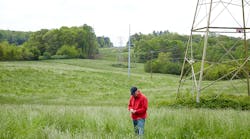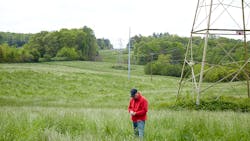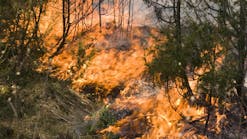ESG Reporting and the Importance of Vegetation Management
It is not uncommon for utility companies to encounter various degrees of public scrutiny. From infrastructure disputes to environmental concerns, today’s utilities are often judged on misperception or misunderstanding. While most organizations can use Environmental, Social and Governance (ESG) reporting to enhance and protect their reputation by sharing information on everything from workforce inclusion and diversity to political and lobbying activities, details associated with biodiversity management may be most impactful for utility companies.
Utility vegetation management programs are essential to ensuring electrical transmission reliability. However, when used exclusively, mechanical mowing and other nonselective control methods commonly used to control incompatible vegetation can decimate desirable plant communities and negatively impact biodiversity. As a result, utilities using these strategies struggle to showcase the environmental impact of their vegetation management programs.
Conversely, Integrated Vegetation Management (IVM) programs are celebrated for the environmental benefits they provide. Utility vegetation managers can unlock the benefits of an IVM-based strategy by complementing mechanical mowing practices with selective herbicide applications. This approach supports electrical transmission reliability and the development of biodiverse habitat for various wildlife species but also lays the groundwork for effective and impactful ESG reporting.
WHY IVM?
Decades of industry research have shown that IVM programs featuring selective herbicide applications are an environmentally friendly approach to controlling incompatible vegetation without disturbing desirable plant communities that represent beneficial habitat for native wildlife.
“When used exclusively, mechanical mowing and other nonselective control methods can result in site disturbance and inhibit the development of native plants,” says Travis Rogers, Market Development Specialist with Corteva Agriscience. “Comparatively, selective herbicide applications can be used as part of an IVM program to target incompatible plant species exclusively. This allows vegetation managers to support the development of compatible plant communities that create biodiverse habitat.”
By supporting the development of biodiverse wildlife habitat, Integrated Vegetation Management strategies featuring selective herbicides enhance results for Environmental, Social and Governance reporting.
Corteva recently launched HabitatWithHerbicides.com to showcase long-term environmental research studies supporting the use of IVM practices throughout utility rights-of-way as well as successful herbicide programs and management techniques that can enhance beneficial wildlife habitat.
As IVM activities intentionally manage both compatible and incompatible vegetation, they commonly qualify for ESG reporting if they prove to yield no net loss or net positive impact on biodiversity. While each utility’s corporate responsibility department can choose to report IVM programming quantitatively or qualitatively on the ESG indices of its preference, the biodiversity sections featured in each support the development of conservation framework that links IVM practices to quantifiable biodiversity metrics and reports qualitative descriptions of habitat initiatives and their environmental impacts.
THE POSITIVE IMPACT OF ESG REPORTING
Utility companies are strongly encouraged by investors and key stakeholders to complete ESG reporting as it provides transparency for their values, ethics and actions. For utility companies, which often receive complaints regarding environmental concerns, lapses in electrical transmission reliability or customer service, ESG reporting provides an opportunity to develop and enhance their public reputation and proactively offset any headwinds they may encounter over time. One common trend that aligns with this strategy is the use of IVM practices throughout utility rights-of-way to support the development of threatened or endangered wildlife species.
INDUSTRY RESOURCES SUPPORTING ESG REPORTING
In recent years, pollinator populations have been on a steep decline, with a loss of habitat noted as a primary cause. With millions of acres of utility rights-of-way weaving throughout the United States, these areas represent an ideal environment in which professionals can effectively support the sustainable development of biodiverse habitat for pollinator species.
Committing to this work serves a dual purpose for utility companies as the same plants that improve pollinator habitat are mostly compatible with the management of utility infrastructure. In other words, embracing IVM practices allows utilities to enhance electrical transmission reliability and support the development of biodiverse habitat for threatened and endangered species — which also complements ESG reporting.
As an organization committed to enhancing safe and reliable energy systems, creating healthier ecosystems and supporting various wildlife species, the Rights-of-Way as Habitat Working Group (ROWHWG) led a multi-sector collaborative effort this past year to create a voluntary conservation agreement for the development of monarch butterfly habitat. The Candidate Conservation Agreement with Assurances (CCAA) encourages landowners and managers to integrate practices and measures that result in net conservation benefits for the monarch butterfly, whose populations have continued to dwindle over the past few years.
As a funding partner of ROWHWG, Corteva encourages utility vegetation managers to use the Pollinator Habitat Scorecard, which was developed by ROWHWG and a group of industry experts to support industrywide tracking and communications regarding habitat on energy and transportation lands. The scorecard also can be used to enhance ESG reporting for utility companies working to align with monitoring and reporting requirements of the Monarch CCAA.
Utility vegetation management professionals interested in learning more about ESG reporting can access industry resources, which provide helpful details regarding different ESG indices and their unique requirements. For more information about strategies to implement IVM principles and achieve results that support ESG reporting, connect with a local vegetation management specialist for expert insights and regional recommendations.
™ ® Trademarks of Corteva Agriscience and its affiliated companies.
Sponsored By:





